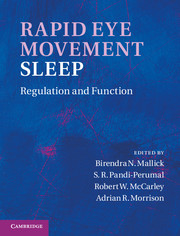Book contents
- Frontmatter
- Contents
- Contributors
- Preface
- Acknowledgments
- Organization
- Section I Historical context
- 1 The sleep–dream state: historic and philosophic perspectives
- 2 REM sleep and dreaming
- 3 REM sleep and dream sleep: are they identical?
- 4 The discovery of REM sleep: the death knell of the passive theory of sleep
- 5 REM sleep and dreaming: the nature of the relationship
- Section II General biology
- Section III Neuronal regulation
- Section IV Neuroanatomy and neurochemistry
- Section V Functional significance
- Section VI Disturbance in the REM sleep-generating mechanism
- Index
- Plate section
- References
4 - The discovery of REM sleep: the death knell of the passive theory of sleep
from Section I - Historical context
Published online by Cambridge University Press: 07 September 2011
- Frontmatter
- Contents
- Contributors
- Preface
- Acknowledgments
- Organization
- Section I Historical context
- 1 The sleep–dream state: historic and philosophic perspectives
- 2 REM sleep and dreaming
- 3 REM sleep and dream sleep: are they identical?
- 4 The discovery of REM sleep: the death knell of the passive theory of sleep
- 5 REM sleep and dreaming: the nature of the relationship
- Section II General biology
- Section III Neuronal regulation
- Section IV Neuroanatomy and neurochemistry
- Section V Functional significance
- Section VI Disturbance in the REM sleep-generating mechanism
- Index
- Plate section
- References
Summary
Summary
Withdrawal from the influence of the outside world seemed a reasonable explanation for the onset of sleep for many years. This view, the passive theory of sleep, held sway despite some evidence to the contrary from lesion and stimulation studies as well as the effects of natural disease of the hypothalamus. Discovery of the ascending reticular activating system did not demolish this idea; for this system was considered merely to transmit the effects of sensory withdrawal, a role previously assigned to long ascending pathways. Even the 1953 discovery of REM sleep, which presented features different from “classical” sleep, could not convince some to abandon the passive theory. By the end of the decade, though, so much evidence for complexity in the organization of sleep and wakefulness had accumulated, including the demonstration of REM sleep in decerebrate cats, that the active theory of sleep finally prevailed.
- Type
- Chapter
- Information
- Rapid Eye Movement SleepRegulation and Function, pp. 31 - 39Publisher: Cambridge University PressPrint publication year: 2011
References
- 2
- Cited by



